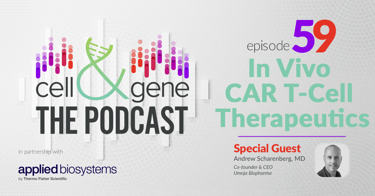Highlights from In Vivo CAR T-Cell Therapeutics With Umoja Biopharma's Dr. Andrew Scharenberg

By Erin Harris, Editor-In-Chief, Cell & Gene
Follow Me On Twitter @ErinHarris_1

Umoja Biopharma’s Dr. Andrew Scharenberg joined me as my guest on a recent episode of Cell & Gene: The Podcast to discuss the evolution of in vivo CAR-T cell therapeutics. Umoja develops in vivo CAR T-cell therapeutics and RACR-induced cytotoxic lymphocytes (iCIL). When crafting the talking points and questions for Andrew’s episode, I was curious to learn how he and his team plan to make CAR T-cell therapies more accessible to more patients. Here are highlights from our conversation.
In Vivo and The Patient Experience
I asked Andy to explain the limitations of ex vivo CAR T-cell therapeutics and the why behind Umoja’s decision to go the in vivo route.
“Look at commercial CAR T-cell products that are being used to treat patients right now. These target antigens for lymphomas and VCAM for multiple myeloma. All those require the logistical complexity of having to collect T cells from a patient, ship them to a central manufacturing facility, bring them back, and then engraft them back into the patient. So the rationale right there is to is to move away from that. That’s expensive. You must have a manufacturer. It's really a service business more than a drug business, right? Because you must have a central facility staffed by expert people who are available all the time. And it adds up. You must have manufacturing slots that have to be reserved so that creates expense and complexity for the patient experience. And in essence, all of that is what’s addressed by the in vivo technology, which is, you deliver in vivo to the patient’s T cells. All that expansion happens in the patient’s body, so effectively their body does the manufacturing. And you've really simplified the process of delivery and ideally made a much more seamless patient experience.”
He went on to share that with an in vivo approach, you’re depending on the patient’s immune system to be as functional as possible because of the delivery to the patient’s own T cells. The fitter and more active the patient’s T cells are the better the type of response. And generally, what you see in patients that go through rounds and rounds of chemotherapy is that the chemotherapy does target the tumor and it targets the tumor because tumor cells are actively proliferating. And very often the way that tumor is targeted through chemotherapy is by affecting the function of the DNA in proliferating cells because DNA obviously must replicate during cell proliferation.
Owning The Supply Chain
Even before sitting down to research Umoja, I had heard of The CLIMB, the Colorado Laboratory and Innovation Manufacturing Building, which is Umoja’s antiviral vector development and manufacturing facility. I’m always curious about the why behind a company’s decision to build an in-house manufacturing facility. It’s a labor- and cost-intensive endeavor, yet it yields control and better visibility. During the height of Covid, Andy and his team had a decision to make.
“The CLIMB came out of our experience in early 2020. Our goal was to work with outside contract manufacturing organizations. But of course, at that point in time, with Covid, when you’re making something very complicated, such as CAR, to work effectively with another organization, you must have people in the same plant working together closely. There are just too many new things to be able to transmit every detail of a protocol verbally over a zoom, for example, and we were finding that that we simply couldn’t work effectively under covid restrictions. And we had no understanding of the timeline for how long these restrictions would last. So that was an impetus for creating our own manufacturing building. I think we realized that with a new class of drug product, being able to own the entire supply chain, from the technology all the way through manufacturing where there's a lot of innovation, is important. That’s an incredibly comforting story to be able to tell a partner. They’re not coming to us just for technology. Let’s suppose we're partnering with another group that wants to utilize our VivoVec platform to deliver their CAR. They give us their CAR, and we can incorporate it into our VivoVec platform and then deliver them back drug product, which they can then take into clinical testing. There’s no third party that must be involved that would then generate and make their product.”
Tune in to hear the entire conversation, including Andy’s take on some of the biggest challenges facing vector manufacturing regarding quality and processing.
